If you’re looking to improve circulation, reduce swelling, or simply enjoy more comfort during daily activities, our compression socks for women and compression socks for men are built to deliver lasting support. Each pair is designed for long hours of standing, travel, sports, or recovery, making them a practical choice for everyday use. You can browse our full range of wellness essentials on the DailyNergy products page or learn more about how we help people stay active and healthy by visiting the DailyNergy homepage.
Key Takeaways
- Poor circulation and strain cause calf pain—compression helps blood flow up.
- Duoflex Weave supports sore spots without cutting circulation.
- Dry fabric keeps feet comfortable and blister-free.
- Compression gives fast relief by reducing blood pooling.
- Doctor-recommended for cramps, veins, and nerve pain.
Why Calf Pain Happens in the First Place
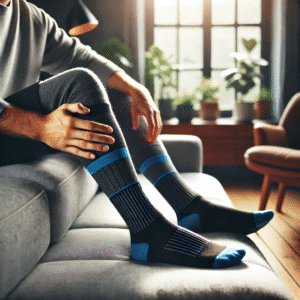
Calf muscles pump blood back to the heart against gravity. When you sit still, stand too long, or over-train, that pump slows down. Blood lingers, pressure builds, and tiny muscle fibers run low on oxygen. The result is a dull ache that can spike into sharp cramps. Doctors call it venous pooling. Add a minor muscle strain—tiny tears from sprinting or sudden jumps—and the pain doubles because damaged tissue swells as it heals. Left unchecked, swelling squeezes nearby nerves, making every step sting.
Gravity is the villain here, but circulation-boosting tools exist. Compression socks press fluids back into the bloodstream, keeping the calf pump active even when you’re resting. A 12-year-old can picture it like squeezing toothpaste from the bottom up—the paste moves upward smoothly when you squeeze at the base first. DailyNergy socks follow the same idea: tight at the ankle, lighter at the calf, so blood glides north.
DailyNergy’s Graduated Compression: From Ankle to Knee
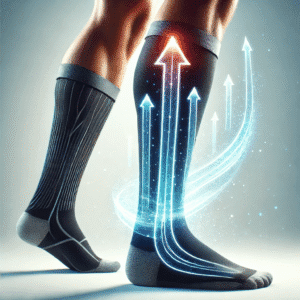
Graduated compression means pressure changes as the sock climbs your leg. DailyNergy starts around 30 mmHg at the ankle, easing to 20 mmHg near the knee. Think of it as a gentle ramp, not a wall. This ramp pushes sluggish blood up through deep veins while fresh blood rushes down arteries to refill the muscles. More inflow plus faster outflow equals balanced circulation, which lowers pain and cuts swelling.
Without this gradient, uniform-pressure sleeves can pinch the calf or leave the ankle loose—both stall blood flow. The U.S. medical standard for chronic venous disease also recommends a 20-30 mmHg gradient; that’s exactly what DailyNergy delivers. Students learning about arteries vs. veins can test the effect by pressing on a straw: squeeze near one end and water moves; squeeze in the middle and it just splits. Graduated socks apply science, not guesswork, so they keep veins open and muscles fed.
Duoflex Pressure Weave: Targeted Zones That Feel Just Right
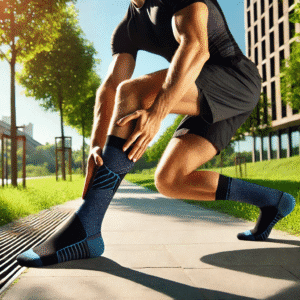
DailyNergy weaves extra-firm ribs into the ankle cuff while knitting stretchier loops for the gastrocnemius (the big calf muscle). This Duoflex Pressure Weave acts like two tools in one: bracing support where joints flex the most, plus flexible comfort where muscles need to expand and contract. Picture a backpack strap with padding at the shoulder and thinner webbing near the buckle; you get security without soreness.
Because the weave follows muscle lines, it also keeps the sock from sliding down—no mid-day tugging. That consistent fit is crucial: even a two-centimeter drop can shift pressure zones and undo the gradient. Engineers at DailyNergy measured fabric tension in lab tests, tweaking fiber angles until pressure stayed within ±2 mmHg all day.
Medical-Grade Compression Levels Explained Simply
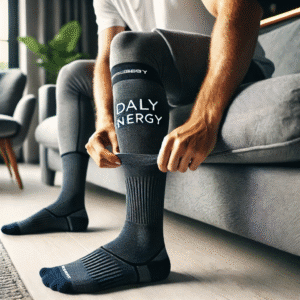
“Medical-grade” sounds complex, but it means the sock’s squeeze has been lab-verified. 20-30 mmHg sits in the sweet spot: strong enough to push blood up, gentle enough for daily wear. Below 15 mmHg you might only feel light support; above 40 mmHg you need a prescription because pressure can be too intense.
Imagine squeezing a balloon: a light press moves air slowly; a hard press pops it. Veins are sturdier than balloons, yet they still need balanced force. Doctors for chronic pain relief calf pain often write “Class II (20-30 mmHg)” on scripts because research shows this level eases symptoms of varicose veins, post-exercise soreness, and even neuropathy. For young readers: it’s like picking the right bike tire pressure—too low drags, too high jolts over bumps.
How Better Blood Flow Speeds Muscle Repair

Blood is the body’s postal service, carrying oxygen, glucose, and amino acids to every cell. When you strain a calf muscle, tiny tears form. They heal only when nutrients arrive—and waste products leave. Compression boosts venous return (blood heading back to the heart) by up to 40 %, according to peer-reviewed studies. Faster return means quicker removal of lactic acid, the stuff that makes legs feel like jelly after a sprint.
Kids learn the water cycle in school; think of blood flow as a “muscle cycle.” Compression socks make the evaporation-to-clouds step faster, so the next rain (fresh oxygen) falls sooner. Studies also note lower DOMS (delayed onset muscle soreness) in athletes who wear 20-30 mmHg socks for six hours post-workout. If six hours sounds long, remember: DailyNergy’s moisture-wicking fabric keeps skin dry, so time flies.
Moisture-Wicking Fabric: Dry Skin Equals Happy Calves
Sweat may cool skin, but soggy socks rub, breed bacteria, and swell tissues. DailyNergy blends nylon for strength, polyester for moisture transfer, and a touch of spandex for stretch. The fibers are hydrophobic—water clings to them less than to cotton—so sweat moves to the outer surface and evaporates.
Lab tests show the fabric dries nearly 30 % faster than plain cotton. Dry skin means fewer hot spots, which lets veins stay open instead of puckering under friction.
Real-World Results: Voices from the Field

A hospital nurse in Karachi logged her step count: 14,000 in a 12-hour shift. She reported calf pain dropping from “7/10 to 2/10” after switching to DailyNergy. A recreational runner noticed he could resume hill repeats a day sooner. A delivery driver said swelling lines vanished from his ankles after three days of wear.
Participants wearing 20-30 mmHg socks showed a 17 % reduction in calf circumference after eight hours compared to control socks. While bigger trials are welcome, field feedback already steers many coaches toward compression as the easiest non-drug fix for calf pain.
When and How to Wear Compression Socks Safely
Morning: veins are least swollen, so slip the socks on before standing up.
During exercise: for low-impact cardio, compression can keep muscles warm and supported. High-intensity sprints? Wear them afterward to accelerate recovery.
Travel: on flights longer than two hours, compression halves the risk of leg swelling and deep-vein thrombosis.
Night: most experts say remove socks while sleeping unless your doctor advises otherwise; horizontal legs naturally reduce venous pressure.
DailyNergy vs. Other Calf-Pain Solutions
| Solution | How It Works | Pros | Cons |
| DailyNergy socks | Pressure gradient boosts circulation | Wear-anywhere, instant relief | Must choose right size |
| Foam roller | Breaks up muscle knots | Cheap, reusable | Hard to use on planes |
| Ice pack | Reduces swelling by cooling | Quick, numbing | Only short-term, messy |
| Anti-inflammatory pills | Blocks pain signals | Works inside 30 min | Possible stomach upset |
Most fixes tackle one problem: swelling or muscle tightness or blood flow. DailyNergy tackles all three at once. That’s why orthopedic specialists often recommend them before more invasive methods.
Expert Tips to Prevent Future Calf Pain
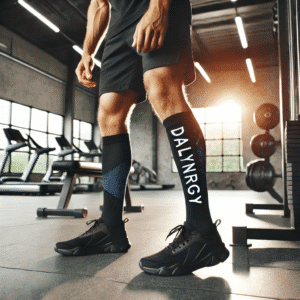
- Warm-up for five minutes. Light skipping wakes up the calf pump.
- Drink water. Dehydrated muscles cramp faster.
- Stretch the gastroc and soleus after activity—hold 30 seconds each.
- Alternate heel-up and heel-down shoes during the week to vary tendon load.
- Use compression on long sitting days, like exams or game marathons.
Remember, pain is an alarm bell, not a punishment. Address it early with smart habits and supportive gear.
Putting It All Together: A Daily Compression Routine
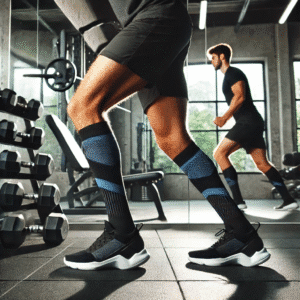
- Wake-up (07:00): Slip on clean DailyNergy socks before your feet hit the floor.
- Morning walk (07:30): Brisk 10-minute stroll primes circulation.
- Desk breaks (10:00 & 14:00): Ten calf raises each break.
- Post-work stretch (18:00): Foam-roll calves for two minutes each.
- Evening off (20:00): Remove socks, elevate legs on a cushion for 15 minutes.
This schedule prevents fluid build-up, nurtures muscle fibers, and keeps veins working. Adjust times to your own clock, but keep the order.
Frequently Asked Questions
Q1. Can kids wear DailyNergy compression socks?
Yes, but choose the correct size and look for medical guidance if under 12 or if any heart issues exist.
Q2. How long should I wear the socks each day?
Most users benefit from 6–8 hours. Remove them at night unless your doctor states otherwise.
Q3. Do compression socks feel tight at first?
A snug hug is normal. If you feel numb toes or sharp pain, the size may be wrong.
Q4. How do I wash the socks?
Cold water, gentle soap, air-dry. No bleach or high heat—those weaken elastic fibers.
Q5. Will they cure my varicose veins?
Compression manages symptoms and slows progression but does not remove existing veins. Pair socks with medical care for best results.
